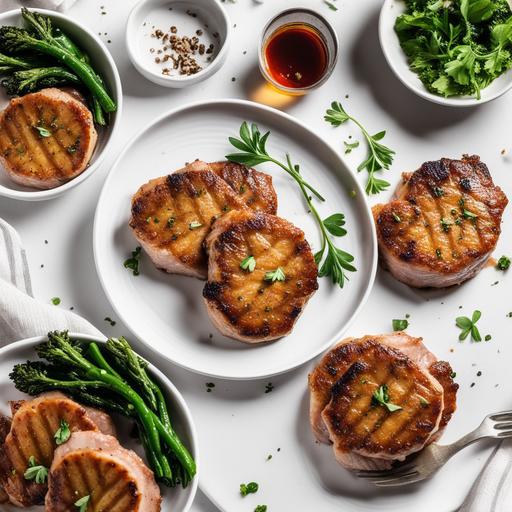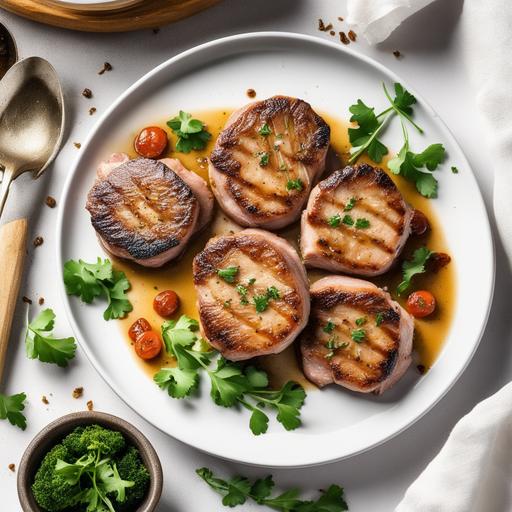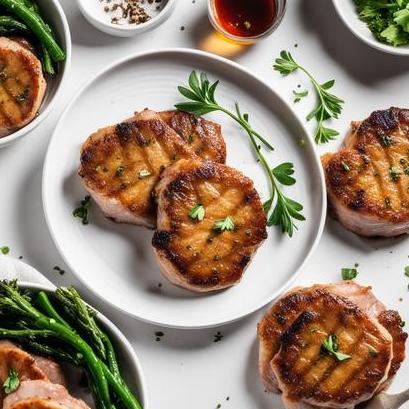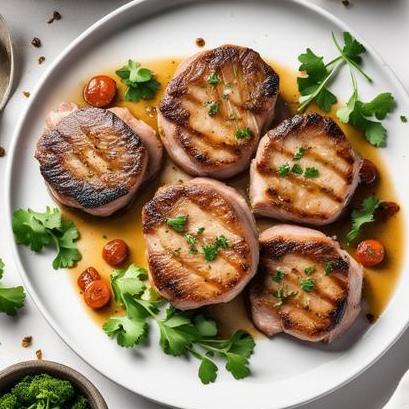
The Perfect Pork Medallions: A Succulent Oven Recipe
Welcome to our comprehensive guide on preparing the most delectable pork medallions in the comfort of your own kitchen! This article will equip you with an in-depth understanding of the science behind food preparation while diving into the culinary details of this succulent dish. Whether you are a seasoned chef or a culinary enthusiast, we guarantee that this article will inspire you to create mouthwatering pork medallions that will impress even the most discerning palates.
Food Science: Understanding Pork Medallions
Before we embark on this culinary adventure, it is crucial to comprehend the science behind pork medallions. Pork medallions are cuts of meat obtained from the tenderloin area of a pig. Known for their tenderness and mild flavor, pork medallions provide a versatile canvas for a wide range of culinary creations. The secret of their succulence lies in the marbling of fat within the meat, which melts during cooking, infusing the medallions with incredible flavor and juiciness.
Selection and Cleaning: Choosing the Perfect Cut
To ensure the highest quality dish, it is imperative to select fresh and well-marbled pork medallions. When purchasing, look for cuts that are a vibrant pink color, with a fine grain and white marbling throughout. This marbling will be responsible for the moist and tender texture of the cooked medallions.
Once you have acquired your desired cuts, it’s time to give them a thorough cleaning. Begin by rinsing the pork medallions under cold water to remove any excess blood or bone fragments. Pat them dry gently with paper towels, ensuring that all moisture is absorbed, allowing for better browning during the cooking process.
Preparation: Unleashing the Flavors

To maximize the flavor potential of your pork medallions, let’s delve into the preparation stage. Below are essential steps to ensure that your dish retains its moistness, tenderness, and tantalizing taste:
Marinating the Medallions
Marinating your medallions not only infuses them with delightful aromatics but also tenderizes the meat, resulting in an exceptional dining experience. Choose your favorite marinade – whether it’s a robust blend of herbs and spices or a subtle mixture of citrus and honey. Massage the marinade into the pork medallions, ensuring they are evenly coated. Cover the marinated medallions and place them in the refrigerator for at least an hour, or preferably overnight, for the most remarkable results.
Seasoning and Spice Rubs
Alternatively, you may opt to use dry rubs or simple seasonings to enhance the flavor profile of your pork medallions. Experiment with various combinations of spices, such as paprika, garlic powder, cumin, or even a hint of cinnamon, all of which contribute to a captivatingly aromatic and mouthwatering dish. Liberally apply your chosen seasoning to the pork medallions, gently pressing it into the surface to ensure it adheres well.
Tips and Tricks: Mastery of the Medallions

Successful preparation of pork medallions takes into account the subtle nuances of culinary finesse. Here are some tips and tricks to ensure that your medallions turn out impeccable every time:
Searing for a Mouthwatering Crust
Achieving a tantalizing crust on the outside of your pork medallions is crucial to the overall dish’s success. To achieve this, it is recommended to start by searing them in a hot skillet before transferring them to the oven. This initial sear not only imparts a visually appealing golden-brown color but also enhances the medallions’ rich flavors.
Resting Period for Tender Juiciness
Allowing your pork medallions to rest once they are cooked is vital for achieving tender, juicy results. Resting allows the meat’s fibers to relax, resulting in a tender and succulent bite. Cover the cooked medallions loosely with aluminum foil and let them rest for at least 5-10 minutes before serving. Use this time to prepare your accompaniments or relish the tantalizing aromas wafting from your oven-fresh dish.
Variations: Exploring Culinary Creativity

Now that you have mastered the basics, it’s time to embrace your culinary creativity and explore various flavor combinations and cooking techniques. Below are some exciting variations that will elevate your pork medallions to a higher level:
Citrus Infusion
For a refreshing twist, infuse your pork medallions with vibrant citrus flavors. Consider marinating them in a blend of lemon and orange zest, paired with fresh herbs like thyme or rosemary. This combination adds a zesty brightness to the dish, perfectly complementing the pork’s tenderness.
Herbaceous Bliss
Herbs and pork medallions are a match made in culinary heaven. Experiment with aromatic herbs such as sage, tarragon, or parsley. Apply them as a dry rub or incorporate them into your marinade, allowing their flavors to infuse the meat. The result will be a fragrant, savory delight that will have your guests coming back for seconds.
Doneness Checks: The Art of Cooking Time

Determining the doneness of your pork medallions is integral to achieving the perfect balance between tenderness and food safety. Utilize a meat thermometer to ensure precision in reaching your desired level of doneness:
-
Medium-Rare: 135°F (57°C)
-
Medium: 145°F (63°C)
-
Medium-Well: 150°F (66°C)
-
Well-Done: 160°F (71°C)
Remember, it’s always better to slightly undercook the pork medallions, as they will continue to cook while resting.
Recipe: Unveiling the Oven Technique
Let’s now unveil the oven technique for preparing succulent pork medallions that will exceed your expectations. Follow the recipe below for a truly exceptional culinary experience:
Ingredients:
-
4 pork medallions, approximately 1 inch thick
-
2 tablespoons olive oil
-
Salt and pepper to taste
Instructions:
-
Preheat your oven to 400°F (200°C).
-
Heat olive oil in an oven-proof skillet over medium-high heat.
-
Season both sides of the pork medallions generously with salt and pepper.
-
Place the pork medallions in the hot skillet and sear each side for 2-3 minutes until golden brown.
-
Transfer the skillet to the preheated oven and bake for 8-10 minutes, or until the internal temperature reaches your desired level of doneness.
-
Remove the skillet from the oven and loosely cover it with aluminum foil. Allow the pork medallions to rest for 5 minutes.
-
Serve the rested pork medallions with your choice of sides and enjoy!
Overcooking and Undercooking: Finding the Sweet Spot
Achieving the perfect balance between overcooking and undercooking can be a delicate process when dealing with pork medallions. Here’s how to navigate this fine line:
The Perils of Overcooking
Overcooked pork medallions can quickly turn dry, tough, and lacking in flavor. To avoid this culinary disaster, closely monitor the cooking time and internal temperature while ensuring a proper resting period. Keep experimenting until you find the ideal balance that guarantees succulent results.
Avoiding the Danger of Undercooking
Undercooked pork medallions can pose a potential health risk. It is essential to invest in a reliable meat thermometer to eliminate any guesswork from the cooking process. Aim for the optimal internal temperature while considering the residual cooking that occurs during the resting period.
Conclusion: A Culinary Masterpiece
Congratulations! You have successfully embarked on a culinary journey that delves deep into the art of preparing pork medallions. By understanding the science behind the dish, practicing proper selection, cleaning, and preparation techniques, and harnessing the power of creative variations and culinary finesse, you are well on your way to becoming a master in the kitchen.
Remember, the key to exceptional pork medallions lies in the perfect balance of flavors, textures, and cooking times. Enjoy the process, experiment, and savor the joy of creating an exquisite dish that will tantalize taste buds and keep your dining companions longing for more. So, go forth, armed with newfound knowledge and culinary prowess, and delight in the creation of succulent pork medallions that will fill your home with an unforgettable aroma and leave your guests in awe. Bon appétit!
Sources
FAQS On Pork Medallions Oven Recipe
What Are Pork Medallions?
Pork medallions refer to thin slices of pork tenderloin that are typically cut into round or oval shapes. They are a lean and tender cut of meat that can be cooked quickly and easily.
How Do I Choose The Right Pork Tenderloin For Making Pork Medallions?
When selecting pork tenderloin for making medallions, look for a piece of meat that is firm and has a pinkish color. Avoid any meat that appears dark or has a strong odor. Additionally, choose a tenderloin that is evenly sized to ensure that the medallions cook evenly.
What Ingredients Do I Need For A Pork Medallions Oven Recipe?
To make pork medallions in the oven, you’ll need the following ingredients:
- Pork tenderloin
- Olive oil
- Salt and pepper
- Herbs and spices of your choice (such as garlic powder, paprika, or thyme)
How Do I Cook Pork Medallions In The Oven?
To cook pork medallions in the oven, preheat your oven to a temperature of 400°F (200°C). Season the pork medallions with salt, pepper, and any additional herbs or spices. In a skillet, heat some olive oil over medium-high heat and sear the pork medallions for 2-3 minutes on each side until browned. Transfer the seared medallions to a baking dish and place it in the preheated oven. Bake for approximately 10-12 minutes, or until the internal temperature of the pork reaches 145°F (63°C). Remove from the oven and let the medallions rest for a few minutes before serving.
How Can I Ensure That My Pork Medallions Turn Out Juicy And Tender?
To ensure juicy and tender pork medallions, it is essential not to overcook them. Overcooking can lead to dry and tough meat. It is recommended to use an instant-read meat thermometer to check the internal temperature of the pork medallions. Aim for a temperature of 145°F (63°C), which will result in medium doneness. Additionally, allow the cooked medallions to rest for a few minutes before serving. This helps the juices redistribute and keeps the meat moist.



